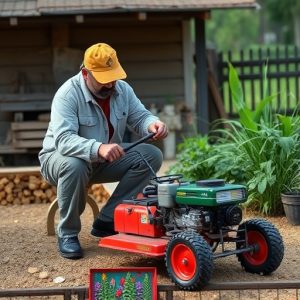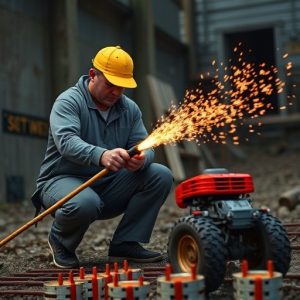Mastering the Kubotan: A Guide to Self-Defense Techniques and Advanced Tactics
mastering the Kubotan requires a comprehensive understanding and skillful application of this self-…….
mastering the Kubotan requires a comprehensive understanding and skillful application of this self-defense tool. Initial training focuses on familiarizing oneself with the Kubotan's balance and handling for accurate strikes, with an emphasis on precise target acquisition to minimize harm. As one progresses, the integration of the Kubotan into advanced self-defense techniques such as disarming, joint locks, and pressure point strikes is crucial for effectively neutralizing threats at close range. Proficiency with the Kubotan demands a high level of fluidity, confidence, and control, which are developed through scenario-based training that treats the tool as an extension of the body. Advanced techniques include strategic breaking maneuvers that utilize the physics of force application to break boards or concrete without relying on sheer strength, and striking with precision to hit critical body points. Regular practice is essential for incorporating the Kubotan into martial arts training, enhancing self-defense capabilities in close-quarters combat, and complementing empty-hand techniques. The article emphasizes that how to use a Kubotan effectively involves a deep intuitive understanding, not just rote memorization, and is best learned through controlled practice under the guidance of an experienced instructor to ensure safety and mastery.
Explore the dynamic world of self-defense with an in-depth look at the Kubotan, a versatile and potent tool for martial artists. This article delves into mastering the Kubotan’s fundamental techniques for personal protection, advanced tactics for breaking and striking with precision, and integrating this instrument into your existing martial arts practice and training routines. Discover how to use a kubotan effectively through expert guidance tailored for both novices and seasoned practitioners.
Mastering the Kubotan: Fundamental Techniques for Self-Defense
Mastering the Kubotan requires a comprehensive understanding of its applications and a series of fundamental techniques that serve as the foundation for effective self-defense. The Kubotan is a short, thick stick that can be used as an impact weapon or to control an opponent’s limb. To adeptly use a Kubotan, one must begin with basic handling skills, learning how it balances and feels in the hand. This familiarity enables users to execute strikes with precision and control. Practitioners should start with drills that focus on target acquisition, aiming for bony areas where a strike can be most effective without causing unnecessary harm.
Advanced techniques build upon these foundational skills by incorporating the Kubotan into various self-defense maneuvers. These include disarming an attacker, joint locks, and pressure point strikes that can neutralize an assailant even in close quarters. Training should emphasize fluidity of movement, ensuring that each technique is executed with both confidence and control. Understanding how to use a Kubotan effectively is not just about memorizing moves but also about developing intuitive responses to potential threats. As such, practice involves simulating real-life scenarios where the Kubotan becomes an extension of the user’s body, allowing for a swift and decisive response in self-defense situations.
Advanced Kubotan Tactics: Breaking and Striking with Precision
Mastery of advanced Kubotan tactics often hinges on the practitioner’s ability to apply the tool with both breaking and striking precision. The Kubotan, a short, thick stick with a cap on one end, is an effective self-defense weapon that extends the range and power of one’s hand techniques. To effectively use a Kubotan for breaking, practitioners must understand the mechanics of force application to break materials such as boards or concrete convincingly. This involves precise angle calculation and the correct amount of force application to avoid injury while achieving the desired outcome. Instructors emphasize control and technique over raw strength, ensuring that students learn to execute these maneuvers with deliberate intent rather than brute force.
Similarly, striking with a Kubotan requires a combination of skill and precision. The technique involves using the Kubotan as an extension of the hand, delivering targeted strikes with accuracy and control. Practitioners must learn to integrate the Kubotan into their striking arsenal, utilizing its weight and length to augment the impact of their blows. Advanced students are taught various striking points on the body, from vulnerable joints to nerve centers, which can incapacitate an attacker. The training focuses on developing a muscle memory that allows for swift and precise application of force in self-defense situations. Understanding how to use a Kubotan effectively for both breaking and striking is not only about the physical execution but also about the strategic placement and timing that can turn the tables in an altercation.
Integrating the Kubotan into Martial Arts Practice and Training Routines
Integrating the Kubotan into martial arts practice and training routines can significantly enhance self-defense skills, offering practitioners a versatile tool for close-quarters combat. The Kubotan is a short, thick stick that can be used with either hand independently or together with an opponent’s hand to control, restrain, or strike. Mastery of how to use a Kubotan requires both physical proficiency and strategic understanding. Incorporating this tool into martial arts training involves learning the nuances of its application, such as pressure point techniques and effective striking points. Practitioners should focus on drills that simulate real-life scenarios where the Kubotan can be employed, emphasizing fluidity of movement and the ability to transition between empty-hand techniques and Kubotan maneuvers seamlessly. Safety is paramount during training, so it’s crucial to start with controlled practice sessions under the guidance of an experienced instructor. As martial artists become adept at the basics, they can explore advanced applications, including the integration of Kubotan use into sparring exercises. This not only sharpens reaction times but also fosters a deeper understanding of its defensive and offensive capabilities within the context of self-defense situations. By consistently practicing with the Kubotan, martial artists can develop a robust skill set that complements their empty-hand techniques, making them well-equipped to handle a variety of confrontational encounters.


